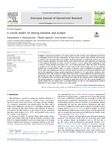Mostrar o rexistro simple do ítem
A simple model for mixing intuition and analysis
| dc.contributor.author | Katsikopoulos, Konstantinos V. | |
| dc.contributor.author | Egozcue, Martin | |
| dc.contributor.author | Fuentes García, Luis | |
| dc.date.accessioned | 2022-10-13T18:46:39Z | |
| dc.date.available | 2022-10-13T18:46:39Z | |
| dc.date.issued | 2022 | |
| dc.identifier.citation | Katsikopoulos, K. V., Egozcue, M., Fuentes García, L. (2022). A simple model for mixing intuition and analysis. European Journal of Operational Research. 303(2), 779-789. | es_ES |
| dc.identifier.uri | http://hdl.handle.net/2183/31804 | |
| dc.description.abstract | [Abstract:] Firefighters, emergency paramedics, and airplane pilots are able to make correct judgments and choices in challenging situations of scarce information and time pressure. Experts often attribute such successes to intuition and report that they avoid analysis. Similarly, laypeople can effortlessly perform tasks that confuse machine algorithms. OR should ideally respect human intuition while supporting and improving it with analytical modelling. We utilize research on intuitive decision making from psychology to build a model of mixing intuition and analysis over a set of interrelated tasks, where the choice of intuition or analysis in one task affects the choice in other tasks. In this model, people may use any analytical method, such as multi-attribute utility, or a single-cue heuristic, such as availability or recognition. The article makes two contributions. First, we study the model and derive a necessary and sufficient condition for the optimality of using a positive proportion of intuition (i.e., for some tasks): Intuition is more frequently accurate than analysis to a larger extent than analysis is more frequently accurate than guessing. Second, we apply the model to synthetic data and also natural data from a forecasting competition for a Wimbledon tennis tournament and a King’s Fund study on how patients choose a London hospital: The optimal proportion of intuition is estimated to range from 25% to 53%. The accuracy benefit of using the optimal mix over analysis alone is estimated between 3% and 27%. Such improvements would be impactful over large numbers of choices as in public health. | es_ES |
| dc.language.iso | spa | es_ES |
| dc.publisher | Elsevier | es_ES |
| dc.relation.uri | https://doi.org/10.1016/j.ejor.2022.03.005 | es_ES |
| dc.rights | Atribución 3.0 España | es_ES |
| dc.rights.uri | http://creativecommons.org/licenses/by/3.0/es/ | * |
| dc.subject | Behavioural OR | es_ES |
| dc.subject | Decision making | es_ES |
| dc.subject | Intuition | es_ES |
| dc.subject | Psychology | es_ES |
| dc.subject | Heuristics | es_ES |
| dc.title | A simple model for mixing intuition and analysis | es_ES |
| dc.type | info:eu-repo/semantics/article | es_ES |
| dc.rights.access | info:eu-repo/semantics/openAccess | es_ES |
| UDC.journalTitle | European Journal of Operational Research | es_ES |
| UDC.volume | 303 | es_ES |
| UDC.issue | 2 | es_ES |
| UDC.startPage | 779 | es_ES |
| UDC.endPage | 789 | es_ES |
| dc.identifier.doi | 10.1016/j.ejor.2022.03.005 |
Ficheiros no ítem
Este ítem aparece na(s) seguinte(s) colección(s)
-
GI-GMNE - Artigos [54]






